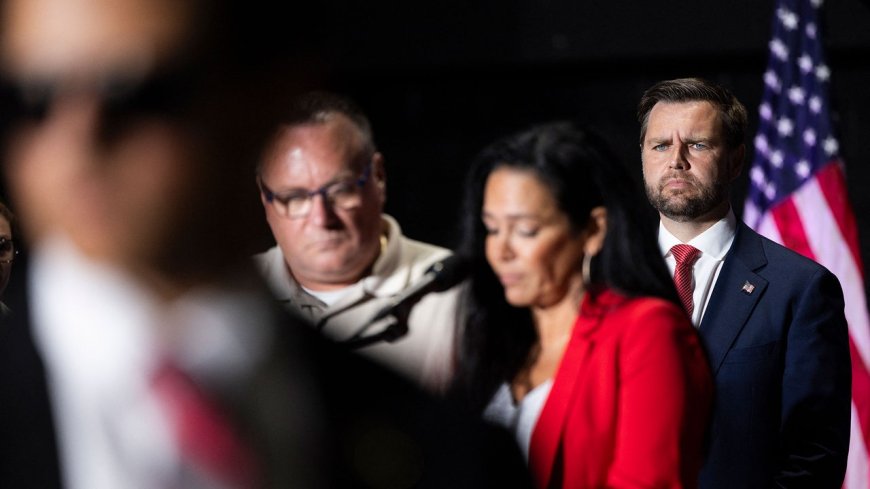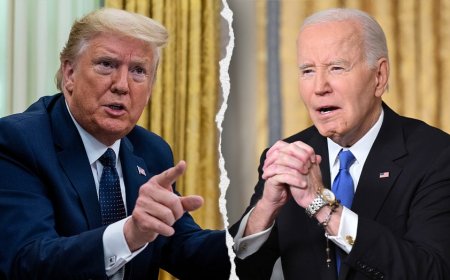Did the Opioid Epidemic Fuel Donald Trump’s Return to the White House?
The LedeNew research suggests that the Democrats’ struggles in communities battling fentanyl addiction had little to do with economic theory or messaging—it was, more simply, a failure of political attention.By Benjamin Wallace-WellsNovember 26, 2024J. D. Vance at a campaign rally in Philadelphia, in August, 2024.Photograph by Ryan Collerd / AFP / GettyMore than any drug since crack, the stories of fentanyl’s spread through the United States brush up against the edge of myth. It is a substance so concentrated that tiny amounts are said to be enough to get vast populations high: a saltshaker’s worth supplies a whole neighborhood; two truckloads keep a country of three hundred and thirty million stocked for a year. In the eighties, stories of the crack trade sometimes followed the historic maps of Black migration. The Chambers brothers, for instance, reportedly employed family members from the Arkansas Delta to conduct distribution operations in high-rise housing projects in Detroit, in conditions that we might now call human trafficking. Such stories were easily exploited by politicians interested in racial demonization, similar to the ways in which fentanyl trafficking is now used to stigmatize migrants crossing the Rio Grande.Like many accounts of illegal activity, these stories, which tend to be sourced from law enforcement, are memorable in a tabloid-noir way, and probably directionally true, but also hard to verify. In the case of fentanyl, they have had a particular resonance for U.S. politicians, who are seeking to make sense of the country’s political turmoil, which might seem out of step with its broadly stable and prosperous society. The fentanyl epidemic suggests that maybe things aren’t really so good here—that instability, violence, and suffering are just below the surface, even though unemployment is under four per cent. It isn’t just Republicans, or cable-news hosts, who have made this an emphasis. Marie Gluesenkamp Perez, a talented young moderate Democratic congresswoman from rural Washington State, has said that forty per cent of infants delivered in one of the largest hospitals in her district are born to at least one parent who is addicted to fentanyl.The LedeReporting and commentary on what you need to know today.There were times, this summer, on the Presidential campaign trail when it seemed to me that 2024 was going to be a fentanyl election. The drug is generally understood to constitute a third wave of the opioid epidemic, the first being misuse of prescriptions like OxyContin and the second being heroin addiction. But fentanyl’s distinguishing feature for public health is its lethality—the rate of people killed from overdoses in the U.S. has more than doubled since 2008 and is nearly seven times what it was in the early eighties. In politics, this helps explain the intensity and durability of immigration as an issue for Trump, whose most recent pitch on the topic was less about jobs and more about drugs and violence. But fentanyl’s presence might also suggest why some of the public seems so alarmed by crime in places where homicide is not peaking and might even help explain why some politically detached young voters seem to have a bleaker view than the economic statistics would imply, since it is their friends—the young—who are dying.In September, as part of a profile of J. D. Vance, I spent some time in Ohio, where, among other things, I was interested in what had made the state move, in the course of two decades, from slightly Republican to convincingly red. My assumption had been that the key was economic anger, over the displacement of manufacturing jobs to China and the long-tail effects of NAFTA. But the Republican officials I met, when asked to explain Ohio’s turn toward right-wing populism, tended to emphasize the opioid epidemic rather than jobs. “For folks around here, it really is protecting the southern border from drugs,” Mark Munroe, the longtime chair of the Mahoning County G.O.P., told me. And Jane Timken, the former Republican state chair, emphasized that the partisan changes had been concentrated in “the pockets of Ohio that were hit so hard by the opioid epidemic.”A few days ago, I came across an economics paper that has been circulating this year, even though it hasn’t yet been formally published. The study, which was authored by Carolina Arteaga, of the University of Toronto, and Victoria Barone, of Notre Dame, takes aim at a specific problem: because the effects of the opioid epidemic have often been worst in areas of the country that have also suffered from depopulation and deindustrialization, and which have been exposed to the NAFTA and China shocks, the social and political consequences of the drugs have been a little tricky to separate from the more general experience of economic hardship and decline.But, in the documents unsealed as part of the Purdue Pharma lawsuits, Arteaga and Barone discovered that, in the mid-nineties, the marketing of OxyContin had


More than any drug since crack, the stories of fentanyl’s spread through the United States brush up against the edge of myth. It is a substance so concentrated that tiny amounts are said to be enough to get vast populations high: a saltshaker’s worth supplies a whole neighborhood; two truckloads keep a country of three hundred and thirty million stocked for a year. In the eighties, stories of the crack trade sometimes followed the historic maps of Black migration. The Chambers brothers, for instance, reportedly employed family members from the Arkansas Delta to conduct distribution operations in high-rise housing projects in Detroit, in conditions that we might now call human trafficking. Such stories were easily exploited by politicians interested in racial demonization, similar to the ways in which fentanyl trafficking is now used to stigmatize migrants crossing the Rio Grande.
Like many accounts of illegal activity, these stories, which tend to be sourced from law enforcement, are memorable in a tabloid-noir way, and probably directionally true, but also hard to verify. In the case of fentanyl, they have had a particular resonance for U.S. politicians, who are seeking to make sense of the country’s political turmoil, which might seem out of step with its broadly stable and prosperous society. The fentanyl epidemic suggests that maybe things aren’t really so good here—that instability, violence, and suffering are just below the surface, even though unemployment is under four per cent. It isn’t just Republicans, or cable-news hosts, who have made this an emphasis. Marie Gluesenkamp Perez, a talented young moderate Democratic congresswoman from rural Washington State, has said that forty per cent of infants delivered in one of the largest hospitals in her district are born to at least one parent who is addicted to fentanyl.
There were times, this summer, on the Presidential campaign trail when it seemed to me that 2024 was going to be a fentanyl election. The drug is generally understood to constitute a third wave of the opioid epidemic, the first being misuse of prescriptions like OxyContin and the second being heroin addiction. But fentanyl’s distinguishing feature for public health is its lethality—the rate of people killed from overdoses in the U.S. has more than doubled since 2008 and is nearly seven times what it was in the early eighties. In politics, this helps explain the intensity and durability of immigration as an issue for Trump, whose most recent pitch on the topic was less about jobs and more about drugs and violence. But fentanyl’s presence might also suggest why some of the public seems so alarmed by crime in places where homicide is not peaking and might even help explain why some politically detached young voters seem to have a bleaker view than the economic statistics would imply, since it is their friends—the young—who are dying.
In September, as part of a profile of J. D. Vance, I spent some time in Ohio, where, among other things, I was interested in what had made the state move, in the course of two decades, from slightly Republican to convincingly red. My assumption had been that the key was economic anger, over the displacement of manufacturing jobs to China and the long-tail effects of NAFTA. But the Republican officials I met, when asked to explain Ohio’s turn toward right-wing populism, tended to emphasize the opioid epidemic rather than jobs. “For folks around here, it really is protecting the southern border from drugs,” Mark Munroe, the longtime chair of the Mahoning County G.O.P., told me. And Jane Timken, the former Republican state chair, emphasized that the partisan changes had been concentrated in “the pockets of Ohio that were hit so hard by the opioid epidemic.”
A few days ago, I came across an economics paper that has been circulating this year, even though it hasn’t yet been formally published. The study, which was authored by Carolina Arteaga, of the University of Toronto, and Victoria Barone, of Notre Dame, takes aim at a specific problem: because the effects of the opioid epidemic have often been worst in areas of the country that have also suffered from depopulation and deindustrialization, and which have been exposed to the NAFTA and China shocks, the social and political consequences of the drugs have been a little tricky to separate from the more general experience of economic hardship and decline.
But, in the documents unsealed as part of the Purdue Pharma lawsuits, Arteaga and Barone discovered that, in the mid-nineties, the marketing of OxyContin had focussed initially on communities with high cancer rates. The idea, apparently, was to build the drug’s brand as a treatment for the terrible pain sometimes experienced by cancer patients before promoting it, in those same communities, as a more general remedy for pain. Arteaga and Barone theorized that by examining the communities with higher and lower rates of cancer, while controlling for measures of economic hardship and social disorder, they could isolate the effects of a community’s opioid exposure from those of a more general decline. Two Appalachian regions might have suffered many of the same injuries, Arteaga and Barone reasoned, but, if only one had high cancer rates, it would have disproportionately got the initial opioid bolus, whose unique effects could then be seen in the differences between regions. “Ingenious,” the Times opinion writer Thomas Edsall called the study’s design, earlier this year.
Arteaga and Barone found that the social harms of the opioid epidemic were substantially exacerbated in the high-cancer regions—what was bad everywhere was worse where OxyContin had first been pushed. By 2012, people in the targeted areas were using opioids at rates fifty per cent higher than those in comparable areas, and dying from these drugs twice as much; in 2020, the populations in these marketing hot zones were about ten per cent more likely to apply for food stamps and social security.
Neither Arteaga nor Barone specializes in U.S. politics—both are originally from South America—but, when they workshopped the paper, they found that other economists often asked whether they could detect any implications for politics, since the other effects were so dramatic. They ran the numbers. The communities that had been pinpointed by Purdue’s reps in the mid-nineties because of high cancer rates became, they found, “increasingly aligned with the Republican party,” across House, gubernatorial, and Presidential elections. Even compared with similar places, which were generally moving toward the G.O.P., and controlling for exposure to economic shocks, the communities targeted by the sales reps—the opioid ground zeros—moved toward the Republicans by an extra 4.6 per cent in the 2020 House elections. In a country on a partisan knife’s edge, this is a remarkable effect. It was as if in their briefcases the sales reps had also carried packets of red dye, its hue still detectable twenty-eight years later in the now-devastated places they’d been.
When I spoke with Arteaga and Barone, via Zoom, on Thursday afternoon, Arteaga said, “It was not obvious that the opioid epidemic would favor the Republicans.” In surveys through the years, people did not especially blame either party for the epidemic. Even so, she thought there might be two reasons that the most affected areas had tilted so clearly to the G.O.P. “The first,” she said, “and I don’t think this would have happened without trade, was that the economic hardship of mostly white working-class Americans became something that was very important to the Republican Party.” The second reason was simpler. “Conservative media talked about this more,” Arteaga said. She and Barone had measured the mentions, and, for many years, the opioid epidemic was much more widely discussed by the right-wing press than by other outlets. You might criticize Fox News for being interested in these patterns mostly in order to demagogue them, in other words, but you have to credit the network for something more important and fundamental: noticing that it was happening at all.
Many post-election op-eds have instructed the Democratic Party to move to the center, or to become more pragmatic, or to break with the neoliberal system more sharply. But the Democrats’ failure in the fentanyl case had little to do with political theory or economic systems. It was, much more simply, a failure of political attention. The history that Arteaga and Barone describe is not one that primarily apportions blame for the fentanyl crisis to more liberal immigration controls at the southern border. Bernie Sanders might look at this material and, not unfairly, call the ongoing suffering of the opioid epidemic a Purdue Pharma plot. But as with the other temporary crises that eventually came to doom the Biden Administration—the withdrawal from Afghanistan, the migrant surge at the southern border, and, perhaps most important, post-pandemic inflation—the Democrats were a little too ready to dismiss the hubbub over opioids as partisan hysteria, and a little too slow to notice that people were actually troubled.
Earlier this summer, while in Philadelphia for a Kamala Harris rally at Temple University, I attended a much smaller J. D. Vance event on the city’s south side which was punctuated by testimonials from family members of opioid addicts. (Vance’s own mother, Beverly Aikins, was, for many years, also addicted to opioids, and the resulting chaos that he grew up in has been an important element of his political story.) It was a sombre affair—a couple relived the tragedy of their daughter’s death after years of addiction and then blamed the Democrats. Before the election, I thought, Is this really the lens through which most Americans see our outwardly thriving country?
But one reason the war on drugs is so interesting is that the illegality of its economy makes it a subterranean force—you can see its effects, but often only after time has passed, or only indirectly. The people who see changes in the traffic most quickly and clearly are often the most vulnerable and marginal. What making sense of the social pressures applied by drugs requires, from both economists and politicians, is discernment: to take in the inexact way the drug world is described, and the racial prejudice that is often embedded in such depictions, and to notice that, within the fog of myth, something important really is happening. ♦


























































